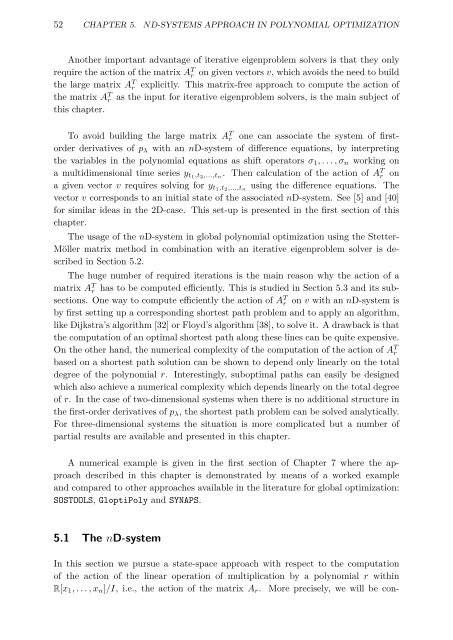link to my thesis
link to my thesis
link to my thesis
Create successful ePaper yourself
Turn your PDF publications into a flip-book with our unique Google optimized e-Paper software.
52 CHAPTER 5. ND-SYSTEMS APPROACH IN POLYNOMIAL OPTIMIZATION<br />
Another important advantage of iterative eigenproblem solvers is that they only<br />
require the action of the matrix A T r on given vec<strong>to</strong>rs v, which avoids the need <strong>to</strong> build<br />
the large matrix A T r explicitly. This matrix-free approach <strong>to</strong> compute the action of<br />
the matrix A T r as the input for iterative eigenproblem solvers, is the main subject of<br />
this chapter.<br />
To avoid building the large matrix A T r one can associate the system of firs<strong>to</strong>rder<br />
derivatives of p λ with an nD-system of difference equations, by interpreting<br />
the variables in the polynomial equations as shift opera<strong>to</strong>rs σ 1 ,...,σ n working on<br />
a multidimensional time series y t1,t 2,...,t n<br />
. Then calculation of the action of A T r on<br />
a given vec<strong>to</strong>r v requires solving for y t1,t 2,...,t n<br />
using the difference equations. The<br />
vec<strong>to</strong>r v corresponds <strong>to</strong> an initial state of the associated nD-system. See [5] and [40]<br />
for similar ideas in the 2D-case. This set-up is presented in the first section of this<br />
chapter.<br />
The usage of the nD-system in global polynomial optimization using the Stetter-<br />
Möller matrix method in combination with an iterative eigenproblem solver is described<br />
in Section 5.2.<br />
The huge number of required iterations is the main reason why the action of a<br />
matrix A T r has <strong>to</strong> be computed efficiently. This is studied in Section 5.3 and its subsections.<br />
One way <strong>to</strong> compute efficiently the action of A T r on v with an nD-system is<br />
by first setting up a corresponding shortest path problem and <strong>to</strong> apply an algorithm,<br />
like Dijkstra’s algorithm [32] or Floyd’s algorithm [38], <strong>to</strong> solve it. A drawback is that<br />
the computation of an optimal shortest path along these lines can be quite expensive.<br />
On the other hand, the numerical complexity of the computation of the action of A T r<br />
based on a shortest path solution can be shown <strong>to</strong> depend only linearly on the <strong>to</strong>tal<br />
degree of the polynomial r. Interestingly, suboptimal paths can easily be designed<br />
which also achieve a numerical complexity which depends linearly on the <strong>to</strong>tal degree<br />
of r. In the case of two-dimensional systems when there is no additional structure in<br />
the first-order derivatives of p λ , the shortest path problem can be solved analytically.<br />
For three-dimensional systems the situation is more complicated but a number of<br />
partial results are available and presented in this chapter.<br />
A numerical example is given in the first section of Chapter 7 where the approach<br />
described in this chapter is demonstrated by means of a worked example<br />
and compared <strong>to</strong> other approaches available in the literature for global optimization:<br />
SOSTOOLS, GloptiPoly and SYNAPS.<br />
5.1 The nD-system<br />
In this section we pursue a state-space approach with respect <strong>to</strong> the computation<br />
of the action of the linear operation of multiplication by a polynomial r within<br />
R[x 1 ,...,x n ]/I, i.e., the action of the matrix A r . More precisely, we will be con-

















